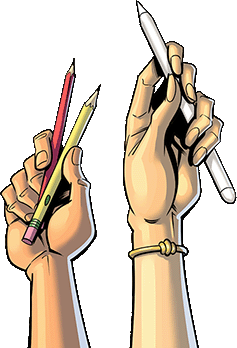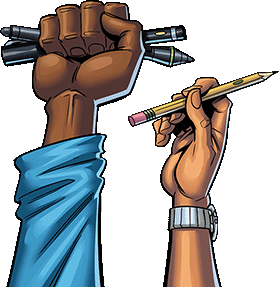Graphic Novels for Fun and Learning
April 13, 2021
Teachers and parents often struggle to get students reading more, especially if they are just learning to read and still need help with new words. Even exciting novels and nonfiction works tailored to a particular age range can sometimes be too dense for readers to engage with, especially if the first few pages aren’t interesting.
However, books don’t need to be entirely prose for young people to get meaningful reading practice. The illustrations in graphic novels are helpful for youngsters, but since readers can’t understand the story without reading the text, they’re still motivated to sound out and learn new words.
Introducing graphic novels is a fantastic way of getting kids to read more, even if they’re struggling readers. However, teachers and students can also create their own graphic novels or comic books as an exciting group project. Both these angles allow teachers to take advantage of everything the graphic novel format has to offer.
Literary Devices and Critical Thinking Skills
The literacy value of graphic novels is high, even if they don’t have the same amount of prose and narration as textbooks. Graphic novels can still use imagery, allusion, foreshadowing, and other literary devices in their visuals. Even black-and-white comics may make excellent use of art to draw attention to certain clues in the story.
Detective and mystery stories are perhaps the best example of how readers can benefit from critical thinking while reading graphic novels, but other genres use this to their advantage as well. The problem-solving aspect of many young adult plotlines is still evident even in the graphic novel format.
So although parents and teachers often try to push plain text on young readers, researchers are beginning to understand the value of this alternative literature. A growing body of evidence establishes graphic novels’ place in classrooms for literacy development and improving content knowledge retention.
Reading for Fun
Kids love superheroes and fantasy stories, so comic books and graphic novels naturally attract readers. They have risen in popularity in recent years in large part thanks to social media buzz generated for new series.
Although the traditional comic book and graphic novel demographics have historically been male, the target audience has widened significantly in recent years. Japanese graphic novels known as manga have also spiked in popularity among boys and girls.
One of the most popular author-illustrators in recent years is Cece Bell, who writes realistic but funny stories for kids and teens. The Lunch Lady graphic novel series by Jarrett J. Krosoczka is another fun option.
Keeping perennial favorites in the school library is a great way to keep students engaged. In some cases, students might even come to the library looking for a graphic novel but leave with a more text-heavy and challenging book that catches their eye. Talk to the school librarian about some age-appropriate and compelling graphic novels for your students, including educational ones and adaptations of popular fiction series.
Graphic Novel Adaptations
When gauging the literary value and age-appropriateness of graphic novels for your children or students, remember that there are many graphic novel versions of existing works. These can prove useful for young readers who want to consume long works faster.
The graphic novel adaptation of Percy Jackson and the Olympians remains highly popular with many junior high school and high school students. There are also graphic novel adaptations of older literary works, including To Kill a Mockingbird and The Handmaid’s Tale.
You can often find recommendations for your grade level and subject on teaching blogs all over the internet. Keep in mind that these blogs often contain affiliate links, and you may need to do your research to vet the quality and age-appropriateness of a book.
One of the best series for getting kids interested in history isn’t a direct adaptation but rather a series of graphic novels illustrating various points in history. Nathan Hale's Hazardous Tales tells thrilling stories of war, espionage, and exploration in a format that’s accessible to middle school and high school students.
Special Education and ELLs
Special education settings have unique considerations for students’ learning needs, and although these situations do not always include learning disabilities like dyslexia, they often include reluctant readers. Highly visual learners may be especially responsive to the material presented in this format.
English Language Learners (ELLs) also need scaffolding for learning. In some cases, educational comic books or graphic novels may be an excellent tool for teachers who need to teach content in an engaging and highly visual form. Graphic novels may also be a perfect way for learners to practice reading in English outside the classroom without having to parse long paragraphs and sentences.

Writing and Drawing a Graphic Novel
Young people often think of comic books and graphic novels as something for professional artists to draw, but there is huge potential for young people to create their own comics. Not only is this a great learning experience for the student who is making the graphic novel or comic book, but it can also be a helpful learning tool for the other students in the class.
Projects like this are critical in getting young girls interested in graphic novels and illustration in general. Since so many existing graphic novels are aimed at young men, it can be challenging for young women to imagine series that are by and for them. By inviting them to create their own short comics or longer projects, teachers can introduce them to this visual art form.
A project of this scale is often best for very serious young artists, and teachers should avoid requiring a comic book project from individual students who are not artistically inclined. Plus, even a short comic book is usually more work than is practical for an end-of-unit project.
However, allowing an abbreviated or rough draft version as a classroom project is a fantastic idea. Teachers can consider allowing a comic book version of a significant historical event instead of an essay, for example.
A full comic book version is an excellent project for homeschoolers and other independent learners. Since working on a graphic novel takes large chunks of time, it works best for students who are either free of scheduling constraints or very studious and hard-working.
It’s also an ideal project for special education students or ELLs, especially if they already enjoy graphic novels and are familiar with the artistic and dialogue conventions. Make sure students present a draft of their script to you for feedback before starting the final project.
Comic Books as Group Projects
Because of the length of graphic novels, any required class project that takes the form of a graphic novel should be undertaken as a group. Although group projects can be a challenge for young learners, high school students often respond well to them.
Students may underestimate the amount of work required to create a high-quality comic. Consider having one student write the script and storyboard while another student does the line art and another tackles the coloring or lettering.
For projects longer than eight pages, split the pages among two or more line art artists. Creating a full-length graphic novel or anthology as a class is a huge endeavor, but it is possible for art classes or a highly motivated group of students in a general education course.
Remember that students’ projects should partly be graded on effort, even if the graphic novel is part of an art class. Since students’ fine motor skills are still developing, the comic should be legible but not perfect.
Once the project is finished, reward the students and encourage them to remember what they have learned by getting inexpensive but professional-looking copies of their work. Saddle stitch binding is the least expensive method, and you can include up to 64 pages.
Sparking Creativity
Whether you’re an art teacher or just a hands-on parent, remember not to dismiss graphic novels as a powerful form of communication. Young readers need various formats to process information, and fiction or non-fiction graphic novels can build their comprehension skills.
If you are interested in printing a comic book, count on Comix Well Spring to make the process as easy as possible. We offer both saddle-stitch and perfect bound book printing with low minimum order quantities. Since we print in black and white or color, we can meet your project’s needs while helping you stay within your budget.


